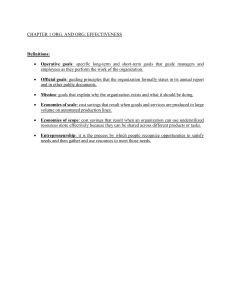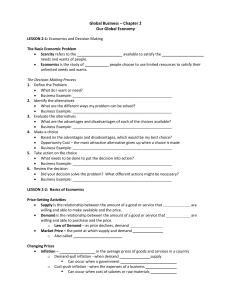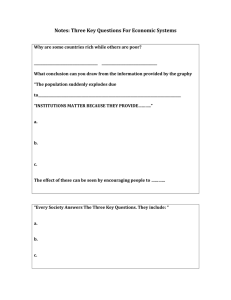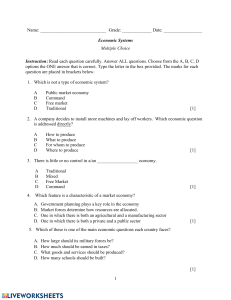Global Economy Module: International Business Concepts
advertisement
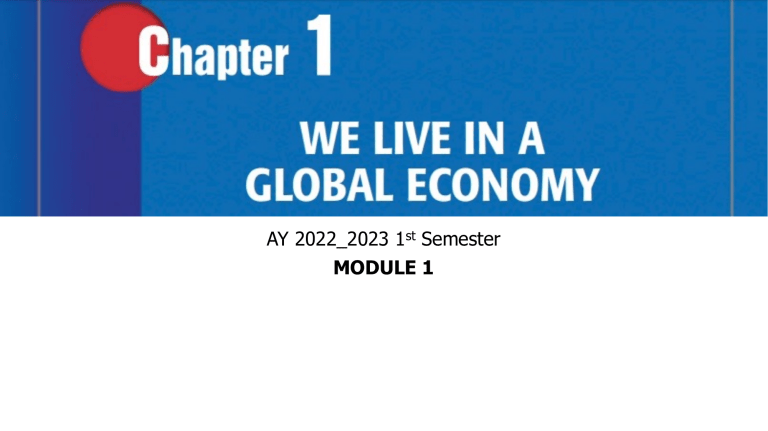
AY 2022_2023 1st Semester MODULE 1 This first module is all entitled Module 1: Living in the Global Economy. This module is an introductory module which will define concepts and perspective in taking up the entire course. Students will also understand the benefits, rewards and risks of Internationalization. At the end of the module, the students must have: 1. Distinguish between domestic business and international business. 2. Explain the components of international business environment consequently know basic skills in dealing with international workers and consumers 3. Describe the factors affecting and differentiate the levels of economic development What is International Business? In the early days of the United States, most families grew the food they ate and made the clothes they wore. Then the population increased. Production and distribution methods improved. People began to depend on others for goods and services. That dependence grew as more people specialized in the work they did. Today, the United States has a complex business system. That system is based on peoples’ specialties and makes a wide variety of items available for use. In many countries, people still work on their own to provide for their daily needs. Most nations do not have the extensive production and distribution facilities that the United States, Canada, Japan, and the western European nations have. Although these countries have some level of economic independence, they are still dependent on other countries. For example, most of the coffee used in the United States comes from Brazil. Japan depends on other countries for much of its oil. Domestic Business vs International Business Most business activities take place inside a country’s own borders. Making, buying, and selling goods and services within a country is called domestic business. If you purchase a soft drink made in your own country, you have been involved in a domestic business. Most business activities take place inside a country’s own borders. Making, buying, and selling goods and services within a country is called domestic business. If you purchase a soft drink made in your own country, you have conducted domestic business. In contrast, if you purchase a shirt made in Thailand, you are now partici- pating in the global economy. Even if you buy the shirt from a U.S. store, it was made by a foreign manufacturer. International business includes all business activities needed to create, ship, and sell goods and services across national borders. International business may also be called global business, international trade, and foreign trade. Why is International Business Important? International business allows you to purchase popular items made in other countries, such as televisions, shoes, and clothing. Without global business, your life would probably be different. People around the world would not have the opportunity to enjoy goods and services made in other countries. International business is important for many reasons. • It provides a source of raw materials and parts and demand for foreign products. • Global business allows for new market and investment opportunities. • It can even help improve political relations. Why is International Business Important? International business allows you to purchase popular items made in other countries, such as televisions, shoes, and clothing. Without global business, your life would probably be different. People around the world would not have the opportunity to enjoy goods and services made in other countries. International business is important for many reasons. • It provides a source of raw materials and parts and demand for foreign products. • Global business allows for new market and investment opportunities. • It can even help improve political relations. When did International Business start? International business is not a new idea. Evidence suggests that countries such as China, India, and Japan were trading products throughout the world 15,000 years ago. There is also evidence that Africans traded with South Americans several thousand years ago. In the fifth century B.C., Greek and Middle Eastern merchants were involved in foreign trade. Later, the Roman Empire dominated international business for more than 600 years. The next few centuries had limited foreign trade activity. The Arab Empire brought together people from Portugal and Spain, northern Africa, the Middle East, and China. Charlemagne created the Holy Roman Empire out of most of Europe. Viking explorers reached Iceland and Greenland. Various inventions created between 1769 and 1915 expanded interest in and opportunities for international business. These discoveries included the cotton gin, the steam engine, and the telephone. The inventions from this period improved communication, distribution, and production. They also helped create new global industries. Recent world events continue to highlight the importance of international business. Expanded trade among companies in different countries increases interdependence. A number of wars in the twentieth century demonstrated The Fundamentals of International Trade These foreign trades usually are not an exchange of items for items. Instead, cash payments are usually made for the items bought or sold. For example, a manufacturing company in Korea can sell radios to an electronics store in the United States. Also, a computer company in the United States might sell its products to a retailer in Russia. These trade activities can be viewed from two sides—the buyer and the seller. For the buyer, products bought from businesses in other countries are called imports. In the previous example, the United States is importing radios. Russia is importing computers. For the seller, exports are products sold in other countries. Using the same example, Korea is exporting radios. The United States is exporting computers. Trade Barriers Although the process sounds simple, obstacles can arise. These obstacles are called trade barriers. Trade barriers are restrictions that reduce free trade among countries. These barriers could appear in several forms. • Import taxes increase the cost of foreign products. • Quotas restrict the number of imports. • Laws prevent certain products from coming into a country. International Business Environment Buying and selling goods and services is similar in most parts of the world. Consumers try to satisfy their needs and wants at a fair price. Businesses try to sell products at a price that covers costs and provides a fair profit. So, International Business is so different with local business because of the environment a businessman has to face in engaging in this kind of business. In many parts of Iran, the exchange of goods and services takes place in an open-air market rather than in an air-conditioned store. Consumers in Japan buy meals that non-Asians might not enjoy, such as raw fish. In Cuba, office workers have been required to work several weeks in the fields to increase the food supply. These are examples of factors that make up the international business operating environment. Look at Figure 1-3. It shows the four major categories of the international business environment. They are geographic condi- tions, cultural and social factors, political and legal factors, and economic conditions. Global Business World International business is an important field of study. Certain basic skills and knowledge are needed in our global economy. There are also a number of obligations and responsibilities that the global economy requires of people. International Business Skills - Certain skills are needed in every type of job. For example, you must be able to read work manuals, do calculations, and write reports. These abilities will continue to be important as business activities among countries increase. There are also a number of other subject areas that are important for global business. • History • Geography • Foreign Language • Cultural Awareness • Study skills The Global Consumer, worker and global citizen Working, voting, and shopping represent three common roles of people in a society. Workers, citizens, and consumers participate in many business activities. These roles expand as a country becomes more involved in international business. As consumer choices increase, the selection of goods and services is no longer limited to items produced in one country. For workers, career opportunities expand because of international business. International trade affects business owners when competitors import or export products. Finally, as citizens, international business activities make it necessary to have an increased awareness of the world. The decisions you make are likely to affect many people in your community, state, country, and world. Each day people throughout the world make economic decisions. For example, selecting what groceries to buy is an economic choice. You are limited by the amount of time and money you have available to acquire the things you want. Countries and individuals have limited resources available. As a result, decisions are necessary to make the best use of resources. Scarcity refers to the limited resources available to satisfy the unlimited needs and wants of people. All people and all nations face scarcity every day. A country must decide whether to grow its own food or to import agricultural products so its workers can produce other items. Many factors affect the choices made by an individual, a company, or a country. The study of how people choose to use limited resources to satisfy their unlimited needs and wants is called Economics. Basics of Economics Price is one of the most visible economic factors you encounter every day. The amount paid for goods and services results from economic decisions made by consumers, businesses, and governments. Determining prices involves two main elements—supply and demand. Supply is the relationship between the amount of a good or service that businesses are willing and able to make available and the price. The amount of an item supplied tends to go up when producers see an opportunity to make money. On the buyer’s side is demand, which is the relationship between the amount of a good or service that consumers are willing and able to purchase and the price. In general, as the amount of a good or service that people want increases, the price of that item goes higher. The point at which supply and demand cross is called the market price. Changing Prices Prices constantly change. The price of a gallon of gasoline over the past 30 years has gone from less than fifty cents to more than two dollars, depending on supply and demand. When the supply of oil (used to make gasoline) was threatened during various Middle East crises, gasoline prices went up. As hostilities lessened, prices dropped. A common economic concern is continually rising prices. An increase in the average prices of goods and services in a country is known as inflation. Inflation allows people to buy fewer goods and services. Inflation is an indi- cation of the buying power of a country’s monetary unit (such as the U.S. dollar, the British pound, or the Japanese yen). Inflation has two basic causes. First, when demand exceeds supply, prices go up. This is called demandpull inflation. It can occur when a government tries to solve economic problems by printing more money. The increased demand comes from the additional currency in circulation. A similar situation can occur if people increase borrowing for spending. Again, demand exceeds supply, and prices tend to rise. The other cause of inflation occurs when the expenses of a business (such as the cost of salaries or raw materials) increase. This is known as cost-push inflation. Cost-push inflation results in a higher price charged by a company. Economic Resources Satisfy Needs Every country makes economic decisions. These decisions provide a basis for solving the basic economic problem—unlimited needs and want with limited resources. The production of goods and services is a primary activity to satisfy the needs and wants of consumers. To start a company that makes a product requires several elements. These elements are the factors of production, which are the three types of resources used to produce goods and services. These resources are natural, human, and capital, as shown in Figure 2-4. Natural Resources – land Human Resources – Labor Capital Resources – Capital Types of Economic Systems Every country must decide how to use its productive resources to answer these three basic economic questions. An economic system is the method a country uses to answer the basic economic questions. Nations organize for production and distribution of goods and services based on customs, political factors, and religious beliefs. Economic systems can be categorized based on ownership of resources and government involvement in business activities. The three common types of economic systems are command, market, and mixed economies. COMMAND ECONOMIES Throughout history, many nations decided to answer the basic economic questions by using central planning. In a command economy, the government or a central-planning committee regulates the amount, distribution, and price of everything produced. The government also owns the productive resources of the country. Any income from these resources is used to help fund government activities. The political and economic environment where the government owns all of the productive resources of the economy and a single party controls the government is called communism. Types of Economic Systems MARKET ECONOMIES In contrast to command economies, where all of the decisions are made by the government, market economies are based on the forces of supply and demand. Market economies are those in which individual companies and consumers make the decisions about what, how, and for whom items will be produced. The economic and political environment where a market economy exists is called capitalism. It has three main characteristics. Private Property - Individuals have the right to buy and sell productive resources and to own business enterprises. Profit motive Individuals are inspired by the opportunity to be rewarded for taking business risks and for working hard. Free, competitive marketplace Consumers have the power to use their choices to determine what is to be produced and to influence the prices to be charged. Since market economies have minimal government involvement with business, they are commonly called free enterprise systems or private enterprise economies. Since every country has some governmental regulations affecting business activities, no perfect market economies exist. Types of Economic Systems MIXED ECONOMIES Many economies are a blend between government involvement in business and private ownership. This is known as a mixed economy. For example, some countries have publicly owned transportation companies, communication networks, and major industries. The income from these enterprises is used to help fund government activities. Socialism refers to a political and economic system with most basic industries owned and operated by government with the government controlled by the people as a whole. In socialism, individuals are usually free to engage in other business opportunities and free to make buy- ing choices. In recent years, examples of socialist countries include Sweden and France. In changing from a command economy to a market economy, a country may sell government-owned industries to private companies. This process of changing an industry from publicly to privately owned is called privatization. In recent years, local governments in the United States have hired private companies to provide services such as trash collection, landscaping, road repairs, and fire protection. Development Factors In some countries, people travel on a high-speed bullet train to manage a computer network in a high-rise building. In other countries, people go by ox cart to a grass hut to operate a hand loom to make cloth for family members and other people in their village. These differences in living and work environments reflect the level of economic development. The main influences on a country’s economic development are literacy level, technology, and agricultural dependency. Literacy level Countries with better education systems usually provide more goods and services that are of higher quality for their citizens. Technology Automated production, distribution, and communications systems allow companies to create and deliver goods, services, and ideas quickly. Agricultural dependency An economy that is largely involved in agriculture does not have the manufacturing base to provide citizens with a large number of high quality products. LESS-DEVELOPED COUNTRIES Many countries of the world have a very low standard of living. A less- developed country (LDC) is a country with little economic wealth and an emphasis on agriculture or mining. Sometimes these countries have abundant resources but no technology to make use of them. DEVELOPING COUNTRIES INDUSTRIALIZED COUNTRIES The nations with the greatest economic power are usually those with many large companies. An industrialized country is a country with strong busi- ness activity that is usually the result of advanced technology and a highly educated population. Such countries have attained high levels of industrialization with high standards of living for their residents. Population tends to be centered in large cities and suburbs rather than in rural areas. Between the extremes of economic development are the developing countries that are evolving from less developed to industrialized. These nations are characterized by improving educational systems, increasing technology, and expanding industries. These factors result in an increasing national income. The Economics of Foreign Trade Countries are interdependent with each other and so are their economies. Consumers have come to expect goods and services from around the world, not just from suppliers in their own country. Buying and selling among companies in different countries is based on two economic principles. Absolute advantage exists when a country can produce a good or service at a lower cost than other countries. This situation usually occurs as a result of the natural resources or raw materials of a country. A country may be able to produce both computers and clothing better than other countries. The world market for computers, however, might be stronger. This means the country would better serve its own interests by producing computers and buying clothing from other countries. This is an example of the second economic principle, comparative advantage. In this situation, a country specializes in the production of a good or service at which it is relatively more efficient. Measuring Economic Progress The World Cup, the World Series, and the Olympics are sports events that involve scorekeeping. As with sports, international business also keeps score. Various economic measures are used to evaluate and analyze the economic conditions of a country. Measure of Production Gross domestic product (GDP) measures the output of goods that a country produces within its borders. It includes items produced with foreign resources. For example, the GDP of the United States would include auto- mobiles manufactured in the United States by foreign-owned companies. Gross national product (GNP) measures the total value of all goods and services produced by the resources of a country. GNP is like GDP but also includes production in other countries using resources of the country whose GNP is being measured. INTERNATIONAL TRADE ACTIVITY An important measure of a country’s international business activity is its balance of trade. Balance of trade is the difference between a country’s exports and imports. When a country exports (sells) more than it imports (buys), it has a favorable balance of trade. This is also called a trade surplus. However, if a country imports more than it exports, the nation has an unfavorable balance of trade, or a trade deficit. In the process of doing international business, payments must be made among businesses in different countries. Since different nations have different monetary units, a comparison of the value of currencies is required. The foreign exchange rate is the value of one country’s money in relation to the value of the money of another country. When you buy more than your current income allows, you go into debt. In the same way, when a country continually has an unfavorable balance of trade, it owes money to others. Foreign debt is the amount a country owes to other countries. Living in the Global Economy Module in review At the end of the module, the students must have: 1. Distinguish between domestic business and international business. 2. Explain the components of international business environment consequently know basic skills in dealing with international workers and consumers 3. Describe the factors affecting and differentiate the levels of economic development
